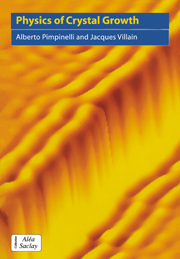Book contents
- Frontmatter
- Contents
- Preface
- List of symbols
- 1 Morphology of a crystal surface
- 2 Surface free energy, step free energy, and chemical potential
- 3 The equilibrium crystal shape
- 4 Growth and dissolution crystal shapes: Frank's model
- 5 Crystal growth: the abc
- 6 Growth and evaporation of a stepped surface
- 7 Diffusion
- 8 Thermal smoothing of a surface
- 9 Silicon and other semiconducting materials
- 10 Growth instabilities of a planar front
- 11 Nucleation and the adatom diffusion length
- 12 Growth roughness at long lengthscales in the linear approximation
- 13 The Kardar-Parisi-Zhang equation
- 14 Growth without evaporation
- 15 Elastic interactions between defects on a crystal surface
- 16 General equations of an elastic solid
- 17 Technology, crystal growth and surface science
- Appendix A From the discrete Gaussian model to the two-dimensional Coulomb gas
- Appendix B The renormalization group applied to the two-dimensional Coulomb gas
- Appendix C Entropic interaction between steps or other linear defects
- Appendix D Wulff's theorem finally proved
- Appendix E Proof of Frank's theorem
- Appendix F Step flow with a Schwoebel effect
- Appendix G Dispersion relations for the fluctuations of a train of steps
- Appendix H Adatom diffusion length ℓs and nucleation
- Appendix I The Edwards-Wilkinson model
- Appendix J Calculation of the coefficients of (13.1) for a stepped surface
- Appendix K Molecular beam epitaxy, the KPZ model, the Edwards-Wilkinson model, and similar models
- Appendix L Renormalization of the KPZ model
- Appendix M Elasticity in a discrete lattice
- Appendix N Linear response of a semi-infinite elastic, homogeneous medium
- Appendix O Elastic dipoles in the z direction
- Appendix P Elastic constants of a cubic crystal
- References
- Index
17 - Technology, crystal growth and surface science
Published online by Cambridge University Press: 07 May 2010
- Frontmatter
- Contents
- Preface
- List of symbols
- 1 Morphology of a crystal surface
- 2 Surface free energy, step free energy, and chemical potential
- 3 The equilibrium crystal shape
- 4 Growth and dissolution crystal shapes: Frank's model
- 5 Crystal growth: the abc
- 6 Growth and evaporation of a stepped surface
- 7 Diffusion
- 8 Thermal smoothing of a surface
- 9 Silicon and other semiconducting materials
- 10 Growth instabilities of a planar front
- 11 Nucleation and the adatom diffusion length
- 12 Growth roughness at long lengthscales in the linear approximation
- 13 The Kardar-Parisi-Zhang equation
- 14 Growth without evaporation
- 15 Elastic interactions between defects on a crystal surface
- 16 General equations of an elastic solid
- 17 Technology, crystal growth and surface science
- Appendix A From the discrete Gaussian model to the two-dimensional Coulomb gas
- Appendix B The renormalization group applied to the two-dimensional Coulomb gas
- Appendix C Entropic interaction between steps or other linear defects
- Appendix D Wulff's theorem finally proved
- Appendix E Proof of Frank's theorem
- Appendix F Step flow with a Schwoebel effect
- Appendix G Dispersion relations for the fluctuations of a train of steps
- Appendix H Adatom diffusion length ℓs and nucleation
- Appendix I The Edwards-Wilkinson model
- Appendix J Calculation of the coefficients of (13.1) for a stepped surface
- Appendix K Molecular beam epitaxy, the KPZ model, the Edwards-Wilkinson model, and similar models
- Appendix L Renormalization of the KPZ model
- Appendix M Elasticity in a discrete lattice
- Appendix N Linear response of a semi-infinite elastic, homogeneous medium
- Appendix O Elastic dipoles in the z direction
- Appendix P Elastic constants of a cubic crystal
- References
- Index
Summary
I ask a lot of these “dumb” questions:
“Is a cathode plus or minus?
Is an an-ion this way, or that way? ”
R. Feynman (Surely you are joking, Mr Feynman!)While the first chapter of this book dwelt on the confirmation of the fundamental ideas of the philosophers of the fifth century BC, this last chapter will be devoted to the twentieth century and to the transformation of our materialistic everyday life brought about by electronics.
The early developments employed electronic tubes which owed nothing to surface physics and crystal growth. Then came the transistor and the realm of silicon, of which huge, dislocation-free crystals can be grown from the melt. In this end of the twentieth century, electromagnetic waves play an increasingly important part. Their production and detection require more and more complex semiconducting materials, often grown by molecular beam epitaxy.
Introduction
The modernity of surface science lies for a large part in the fact that new experimental techniques now make surfaces accessible to investigation. But the present interest in surface physics is also much motivated by the technological importance of crystals grown with a well-controlled composition and a high degree of perfection, and this depends very much on the state of the crystal surface during growth.
The purpose of this chapter is to outline the technological importance of materials with a controlled purity and morphology.
We shall mainly discuss semiconductors. It is not very easy to find simple articles or books explaining semiconductor electronics to the ignorant, but the book by Parker (1994) accomplishes this function.
- Type
- Chapter
- Information
- Physics of Crystal Growth , pp. 277 - 288Publisher: Cambridge University PressPrint publication year: 1998



